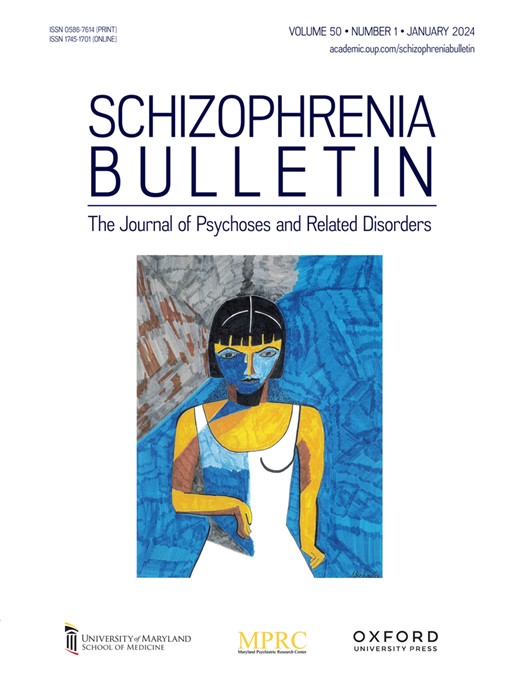精神障碍妇女儿童出生时的胎儿头部生长和头围及人群对照
IF 4.8
1区 医学
Q1 PSYCHIATRY
引用次数: 0
摘要
父母患有精神疾病的孩子患精神健康问题的风险增加50%,超过30%的人在成年早期患上了严重的精神疾病。异常的大脑发育可能是这种家族风险的基础。我们的目的是研究精神障碍妇女的孩子和以人群为基础的对照组之间大脑发育的差异,反映在胎儿头围(HC)生长轨迹和出生时的HC上。研究设计我们从N = 140名诊断为精神障碍的孕妇及其N = 168名儿童的医疗记录中收集了20、30和36周胎龄(GA)的胎儿超声检查结果。在R代研究中,对N = 8605名孕妇及其子女在妊娠早期、中期和/或晚期进行了超声检查。两组均用卷尺测量出生时HC。研究结果:使用广义加性混合模型,我们观察到精神病女性的后代与对照组相比,从30.7周开始,非线性胎儿HC生长下降。出生时,没有观察到显著差异(b = 0.22, 95% CI[-0.133至0.573]),尽管暴露于母亲精神疾病的后代表现出更多的产科并发症和次优出生结局,包括低出生体重(b = -136.1, 95% CI[-229.0至-43.2])。结论:本研究显示,精神障碍妇女的胎儿在妊娠晚期出现胎头生长下降和出生体重下降。总之,这些发现强调了胎儿头部生长改变与后期神经发育结果的潜在相关性,并为精神病风险传播的可能潜在机制提供了方向。本文章由计算机程序翻译,如有差异,请以英文原文为准。
Fetal Head Growth and Head Circumference at Birth in Children of Women with Psychotic Disorders and Population-Based Controls
Background Children of parents with psychotic disorders have a ˃50% increased risk to develop mental health problems, and over 30% have developed severe mental illness by early adulthood. Aberrant brain development may underly this familial risk. We aimed to investigate differences in brain development, reflected in fetal head circumference (HC) growth trajectories and HC at birth, between children of women with psychotic disorders and population-based controls. Study Design We collected fetal ultrasonography assessments at 20, 30, and 36 weeks of gestational age (GA) from medical records of N = 140 pregnant women having a psychotic disorder diagnosis and their N = 168 children. In the Generation R study, ultrasonography assessments were performed in the first, second, and/or third trimester in N = 8605 pregnant women and their children. In both groups, HC at birth was measured with measuring tape. Study Results Using generalized additive mixed modeling, we observed decreased non-linear fetal HC growth for offspring of women with psychotic disorders vs. controls from 30.7 weeks GA onwards. At birth, no significant difference was observed (b = 0.22, 95% CI [–0.133 to 0.573]), although offspring exposed to maternal psychosis showed more obstetric complications and suboptimal birth outcomes, including lower birthweight (b = –136.1, 95% CI [–229.0 to –43.2]). Conclusions This study showed decreased fetal head growth during the third trimester and lower birthweight in children of women with psychotic disorders. Together, these findings highlight potential relevance of altered fetal head growth for later neurodevelopmental outcomes and provide directions for possible underlying mechanisms of risk transmission in psychosis.
求助全文
通过发布文献求助,成功后即可免费获取论文全文。
去求助
来源期刊

Schizophrenia Bulletin
医学-精神病学
CiteScore
11.40
自引率
6.10%
发文量
163
审稿时长
4-8 weeks
期刊介绍:
Schizophrenia Bulletin seeks to review recent developments and empirically based hypotheses regarding the etiology and treatment of schizophrenia. We view the field as broad and deep, and will publish new knowledge ranging from the molecular basis to social and cultural factors. We will give new emphasis to translational reports which simultaneously highlight basic neurobiological mechanisms and clinical manifestations. Some of the Bulletin content is invited as special features or manuscripts organized as a theme by special guest editors. Most pages of the Bulletin are devoted to unsolicited manuscripts of high quality that report original data or where we can provide a special venue for a major study or workshop report. Supplement issues are sometimes provided for manuscripts reporting from a recent conference.
 求助内容:
求助内容: 应助结果提醒方式:
应助结果提醒方式:


